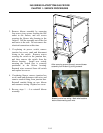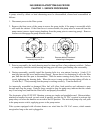
24G SERIES FLATBOTTOM GAS FRYERS
CHAPTER 1: SERVICE PROCEDURES
1-22
If the fryer’s gas and air supplies are okay, the problem most likely is with one of the electrical
components. Examine the ignition module for signs of melting/distortion and/or discoloration due to
excessive heat build-up in the fryer. (This condition usually indicates improper flue performance.).
Also, examine the controller for the same conditions. A melted or distorted ignition module is
automatically suspect and should be replaced, but unless the condition causing excessive heat in the
fryer is corrected, the problem is likely to recur.
Next, ensure the ignition wire is connected properly at both ends and examine it for obvious signs of
damage. Again, if damage is due to excessive heat in the fryer, that problem must also be corrected.
DANGER
MAKE SURE YOU ARE HOLDING THE INSULATED HANDLE OF THE SCREWDRIVER
AND NOT THE BLADE. THE SPARKING CHARGE IS APPROXIMATELY 25,000
VOLTS.
Check for proper operation by disconnecting the wire from the ignitor, inserting the tip of a
screwdriver into the terminal, and holding it near the frame of the fryer as the power switch is placed
in the "ON" position. A strong, blue spark should be generated for at least 11 seconds.
Fluctuating flame intensity is normally caused by either improper or fluctuating incoming gas
pressure, but may also be the result of variations in the kitchen atmosphere. Verify incoming gas
pressure in the same way as for "popping", discussed in the preceding paragraphs. Variations in the
kitchen atmosphere are usually caused by air conditioning and/or ventilation systems starting and
stopping during the day. As air conditioning/ventilation systems start and stop, the pressure in the
kitchen may change from positive or neutral to negative, or vice versa. Changes in airflow patterns
may affect flame intensity.
Flames "rolling" out of the fryer are usually an indication of negative pressure in the kitchen. Air is
being sucked out of the fryer enclosure and the flames are literally following the air. If negative
pressure is not the cause, check for high burner-manifold gas pressure in accordance with the
procedures in Section 1.4. An obstructed flue or a faulty blower, which prevents the fryer from
properly exhausting, may also be the cause.
Excessively noisy burners, especially with flames visible above the flue opening, may indicate that
the burner gas pressure is too high or the gas valve vent-tube is blocked (if applicable). If the gas
pressure is correct, and the vent-tube is unobstructed (if applicable), the gas valve regulator is
probably defective.


















